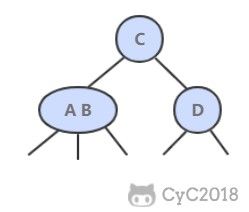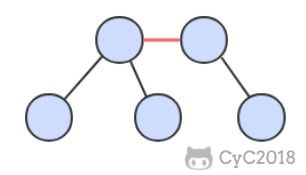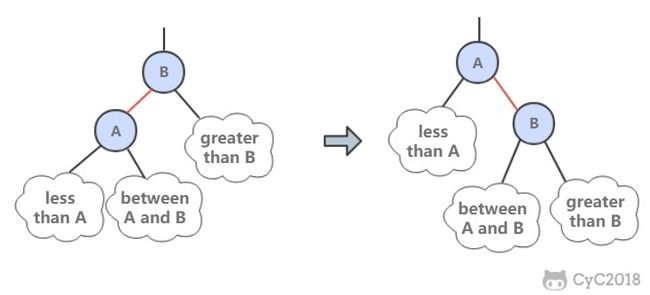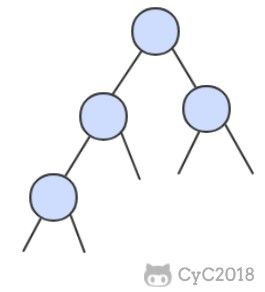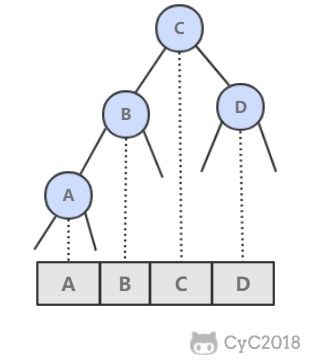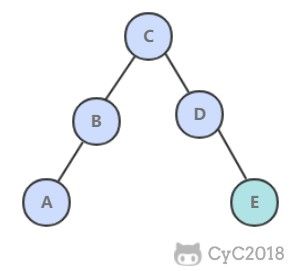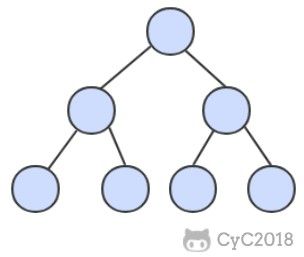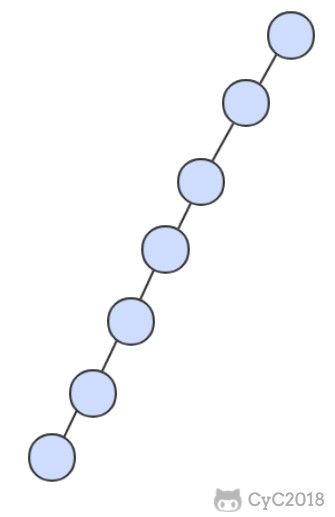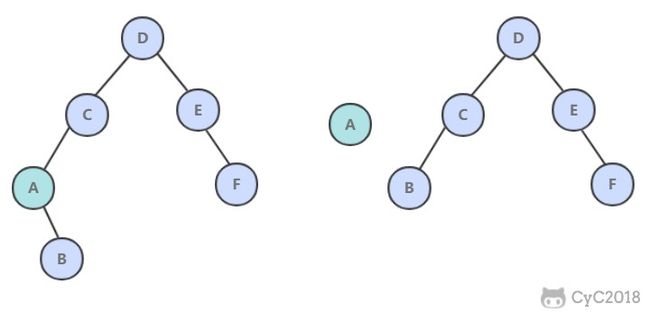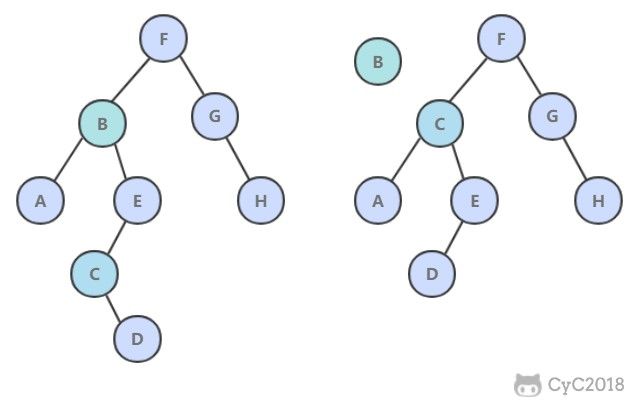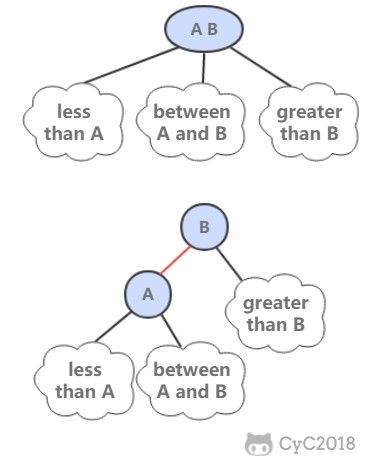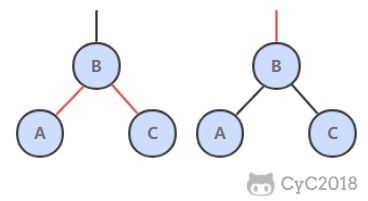2-3查找树和红黑树
2-3查找树引入2-节点和3-节点,目的为了让树平衡。一颗完美平衡的2-3查找树的所有空链接到根节点的距离应该是相同的。
插入操作
插入操作和BST的插入操作有很大区别,BST的插入操作是先进行一次未命中的查找,然后再将节点插入到对应的空链表上,但是2-3查找树如果也这么做的话,那么就会破坏平衡性。它是将新节点到叶子节点上。
根据叶子节点的类型不同,有不同的处理方式:
如果插入到2-节点上,那么直接变成3-节点。
如果插入到3-节点上,那么暂时先变成4-节点,转成三个2-节点,并将中间的节点加入上层节点,如果上层节点也变成了4-那就继续拆分。
性质:
2-3查找树的插入操作都是局部的,只变换相关节点。并不会影响全局有序性和平衡性。
2-3 查找树的查找和插入操作复杂度和插入顺序无关,在最坏的情况下查找和插入操作访问的节点必然不超过 logN 个,含有 10 亿个节点的 2-3 查找树最多只需要访问 30 个节点就能进行任意的查找和插入操作。
红黑树
红黑树是一颗2-3树,他不需要分别定义2-,3-,而是在普通树的基础上,加上颜色,红树那么这个节点和上层节点表示3-,黑的表示普通树。
红黑树具有以下性质:
- 红链接都为左链接;
- 完美黑色平衡,即任意空链接到根节点的路径上的黑链接数量相同。
public class RedBlackBST, Value> extends BST {
private static final boolean RED = true;
private static final boolean BLACK = false;
private boolean isRed(Node x) {
if (x == null)
return false;
return x.color == RED;
}
} 左旋转:
因为合法的红链接都为左链接,如果出现右链接为红链接,那么就需要进行左旋转操作。
public Node rotateLeft(Node h) {
Node x = h.right;
h.right = x.left;
x.left = h;
x.color = h.color;
h.color = RED;
x.N = h.N;
recalculateSize(h);
return x;
}右旋转:
进行右旋转是为了转换两个连续的左红链接
public Node rotateRight(Node h) {
Node x = h.left;
h.left = x.right;
x.right = h;
x.color = h.color;
h.color = RED;
x.N = h.N;
recalculateSize(h);
return x;
}
CS-Notes
- 前言
- 初级实现
- 1. 链表实现无序符号表
- 2. 二分查找实现有序符号表
- 二叉查找树
- 1. get()
- 2. put()
- 3. 分析
- 4. floor()
- 5. rank()
- 6. min()
- 7. deleteMin()
- 8. delete()
- 9. keys()
- 10. 分析
- 2-3 查找树
- 1. 插入操作
- 2. 性质
- 红黑树
- 1. 左旋转
- 2. 右旋转
- 3. 颜色转换
- 4. 插入
- 5. 分析
- 散列表
- 1. 散列函数
- 2. 拉链法
- 3. 线性探测法
- 3.1 查找
- 3.2 插入
- 3.3 删除
- 3.5 调整数组大小
- 小结
- 1. 符号表算法比较
- 2. Java 的符号表实现
- 3. 稀疏向量乘法
前言
符号表(Symbol Table)是一种存储键值对的数据结构,可以支持快速查找操作。
符号表分为有序和无序两种,有序符号表主要指支持 min()、max() 等根据键的大小关系来实现的操作。
有序符号表的键需要实现 Comparable 接口。
public interface UnorderedST {
int size();
Value get(Key key);
void put(Key key, Value value);
void delete(Key key);
} Copy to clipboardErrorCopiedpublic interface OrderedST, Value> {
int size();
void put(Key key, Value value);
Value get(Key key);
Key min();
Key max();
int rank(Key key);
List keys(Key l, Key h);
} Copy to clipboardErrorCopied初级实现
1. 链表实现无序符号表
public class ListUnorderedST implements UnorderedST {
private Node first;
private class Node {
Key key;
Value value;
Node next;
Node(Key key, Value value, Node next) {
this.key = key;
this.value = value;
this.next = next;
}
}
@Override
public int size() {
int cnt = 0;
Node cur = first;
while (cur != null) {
cnt++;
cur = cur.next;
}
return cnt;
}
@Override
public void put(Key key, Value value) {
Node cur = first;
// 如果在链表中找到节点的键等于 key 就更新这个节点的值为 value
while (cur != null) {
if (cur.key.equals(key)) {
cur.value = value;
return;
}
cur = cur.next;
}
// 否则使用头插法插入一个新节点
first = new Node(key, value, first);
}
@Override
public void delete(Key key) {
if (first == null)
return;
if (first.key.equals(key))
first = first.next;
Node pre = first, cur = first.next;
while (cur != null) {
if (cur.key.equals(key)) {
pre.next = cur.next;
return;
}
pre = pre.next;
cur = cur.next;
}
}
@Override
public Value get(Key key) {
Node cur = first;
while (cur != null) {
if (cur.key.equals(key))
return cur.value;
cur = cur.next;
}
return null;
}
} Copy to clipboardErrorCopied2. 二分查找实现有序符号表
使用一对平行数组,一个存储键一个存储值。
二分查找的 rank() 方法至关重要,当键在表中时,它能够知道该键的位置;当键不在表中时,它也能知道在何处插入新键。
二分查找最多需要 logN+1 次比较,使用二分查找实现的符号表的查找操作所需要的时间最多是对数级别的。但是插入操作需要移动数组元素,是线性级别的。
public class BinarySearchOrderedST, Value> implements OrderedST {
private Key[] keys;
private Value[] values;
private int N = 0;
public BinarySearchOrderedST(int capacity) {
keys = (Key[]) new Comparable[capacity];
values = (Value[]) new Object[capacity];
}
@Override
public int size() {
return N;
}
@Override
public int rank(Key key) {
int l = 0, h = N - 1;
while (l <= h) {
int m = l + (h - l) / 2;
int cmp = key.compareTo(keys[m]);
if (cmp == 0)
return m;
else if (cmp < 0)
h = m - 1;
else
l = m + 1;
}
return l;
}
@Override
public List keys(Key l, Key h) {
int index = rank(l);
List list = new ArrayList<>();
while (keys[index].compareTo(h) <= 0) {
list.add(keys[index]);
index++;
}
return list;
}
@Override
public void put(Key key, Value value) {
int index = rank(key);
// 如果找到已经存在的节点键为 key,就更新这个节点的值为 value
if (index < N && keys[index].compareTo(key) == 0) {
values[index] = value;
return;
}
// 否则在数组中插入新的节点,需要先将插入位置之后的元素都向后移动一个位置
for (int j = N; j > index; j--) {
keys[j] = keys[j - 1];
values[j] = values[j - 1];
}
keys[index] = key;
values[index] = value;
N++;
}
@Override
public Value get(Key key) {
int index = rank(key);
if (index < N && keys[index].compareTo(key) == 0)
return values[index];
return null;
}
@Override
public Key min() {
return keys[0];
}
@Override
public Key max() {
return keys[N - 1];
}
} Copy to clipboardErrorCopied二叉查找树
二叉树 是一个空链接,或者是一个有左右两个链接的节点,每个链接都指向一颗子二叉树。
二叉查找树 (BST)是一颗二叉树,并且每个节点的值都大于等于其左子树中的所有节点的值而小于等于右子树的所有节点的值。
BST 有一个重要性质,就是它的中序遍历结果递增排序。
基本数据结构:
public class BST, Value> implements OrderedST {
protected Node root;
protected class Node {
Key key;
Value val;
Node left;
Node right;
// 以该节点为根的子树节点总数
int N;
// 红黑树中使用
boolean color;
Node(Key key, Value val, int N) {
this.key = key;
this.val = val;
this.N = N;
}
}
@Override
public int size() {
return size(root);
}
private int size(Node x) {
if (x == null)
return 0;
return x.N;
}
protected void recalculateSize(Node x) {
x.N = size(x.left) + size(x.right) + 1;
}
} Copy to clipboardErrorCopied为了方便绘图,下文中二叉树的空链接不画出来。
1. get()
- 如果树是空的,则查找未命中;
- 如果被查找的键和根节点的键相等,查找命中;
- 否则递归地在子树中查找:如果被查找的键较小就在左子树中查找,较大就在右子树中查找。
@Override
public Value get(Key key) {
return get(root, key);
}
private Value get(Node x, Key key) {
if (x == null)
return null;
int cmp = key.compareTo(x.key);
if (cmp == 0)
return x.val;
else if (cmp < 0)
return get(x.left, key);
else
return get(x.right, key);
}Copy to clipboardErrorCopied2. put()
当插入的键不存在于树中,需要创建一个新节点,并且更新上层节点的链接指向该节点,使得该节点正确地链接到树中。
@Override
public void put(Key key, Value value) {
root = put(root, key, value);
}
private Node put(Node x, Key key, Value value) {
if (x == null)
return new Node(key, value, 1);
int cmp = key.compareTo(x.key);
if (cmp == 0)
x.val = value;
else if (cmp < 0)
x.left = put(x.left, key, value);
else
x.right = put(x.right, key, value);
recalculateSize(x);
return x;
}Copy to clipboardErrorCopied3. 分析
二叉查找树的算法运行时间取决于树的形状,而树的形状又取决于键被插入的先后顺序。
最好的情况下树是完全平衡的,每条空链接和根节点的距离都为 logN。
在最坏的情况下,树的高度为 N。
4. floor()
floor(key):小于等于键的最大键
- 如果键小于根节点的键,那么 floor(key) 一定在左子树中;
- 如果键大于根节点的键,需要先判断右子树中是否存在 floor(key),如果存在就返回,否则根节点就是 floor(key)。
public Key floor(Key key) {
Node x = floor(root, key);
if (x == null)
return null;
return x.key;
}
private Node floor(Node x, Key key) {
if (x == null)
return null;
int cmp = key.compareTo(x.key);
if (cmp == 0)
return x;
if (cmp < 0)
return floor(x.left, key);
Node t = floor(x.right, key);
return t != null ? t : x;
}Copy to clipboardErrorCopied5. rank()
rank(key) 返回 key 的排名。
- 如果键和根节点的键相等,返回左子树的节点数;
- 如果小于,递归计算在左子树中的排名;
- 如果大于,递归计算在右子树中的排名,加上左子树的节点数,再加上 1(根节点)。
@Override
public int rank(Key key) {
return rank(key, root);
}
private int rank(Key key, Node x) {
if (x == null)
return 0;
int cmp = key.compareTo(x.key);
if (cmp == 0)
return size(x.left);
else if (cmp < 0)
return rank(key, x.left);
else
return 1 + size(x.left) + rank(key, x.right);
}Copy to clipboardErrorCopied6. min()
@Override
public Key min() {
return min(root).key;
}
private Node min(Node x) {
if (x == null)
return null;
if (x.left == null)
return x;
return min(x.left);
}Copy to clipboardErrorCopied7. deleteMin()
令指向最小节点的链接指向最小节点的右子树。
public void deleteMin() {
root = deleteMin(root);
}
public Node deleteMin(Node x) {
if (x.left == null)
return x.right;
x.left = deleteMin(x.left);
recalculateSize(x);
return x;
}Copy to clipboardErrorCopied8. delete()
- 如果待删除的节点只有一个子树, 那么只需要让指向待删除节点的链接指向唯一的子树即可;
- 否则,让右子树的最小节点替换该节点。
public void delete(Key key) {
root = delete(root, key);
}
private Node delete(Node x, Key key) {
if (x == null)
return null;
int cmp = key.compareTo(x.key);
if (cmp < 0)
x.left = delete(x.left, key);
else if (cmp > 0)
x.right = delete(x.right, key);
else {
if (x.right == null)
return x.left;
if (x.left == null)
return x.right;
Node t = x;
x = min(t.right);
x.right = deleteMin(t.right);
x.left = t.left;
}
recalculateSize(x);
return x;
}Copy to clipboardErrorCopied9. keys()
利用二叉查找树中序遍历的结果为递增的特点。
@Override
public List keys(Key l, Key h) {
return keys(root, l, h);
}
private List keys(Node x, Key l, Key h) {
List list = new ArrayList<>();
if (x == null)
return list;
int cmpL = l.compareTo(x.key);
int cmpH = h.compareTo(x.key);
if (cmpL < 0)
list.addAll(keys(x.left, l, h));
if (cmpL <= 0 && cmpH >= 0)
list.add(x.key);
if (cmpH > 0)
list.addAll(keys(x.right, l, h));
return list;
} Copy to clipboardErrorCopied10. 分析
二叉查找树所有操作在最坏的情况下所需要的时间都和树的高度成正比。
2-3 查找树
2-3 查找树引入了 2- 节点和 3- 节点,目的是为了让树平衡。一颗完美平衡的 2-3 查找树的所有空链接到根节点的距离应该是相同的。
1. 插入操作
插入操作和 BST 的插入操作有很大区别,BST 的插入操作是先进行一次未命中的查找,然后再将节点插入到对应的空链接上。但是 2-3 查找树如果也这么做的话,那么就会破坏了平衡性。它是将新节点插入到叶子节点上。
根据叶子节点的类型不同,有不同的处理方式:
- 如果插入到 2- 节点上,那么直接将新节点和原来的节点组成 3- 节点即可。
- 如果是插入到 3- 节点上,就会产生一个临时 4- 节点时,需要将 4- 节点分裂成 3 个 2- 节点,并将中间的 2- 节点移到上层节点中。如果上移操作继续产生临时 4- 节点则一直进行分裂上移,直到不存在临时 4- 节点。
2. 性质
2-3 查找树插入操作的变换都是局部的,除了相关的节点和链接之外不必修改或者检查树的其它部分,而这些局部变换不会影响树的全局有序性和平衡性。
2-3 查找树的查找和插入操作复杂度和插入顺序无关,在最坏的情况下查找和插入操作访问的节点必然不超过 logN 个,含有 10 亿个节点的 2-3 查找树最多只需要访问 30 个节点就能进行任意的查找和插入操作。
红黑树
红黑树是 2-3 查找树,但它不需要分别定义 2- 节点和 3- 节点,而是在普通的二叉查找树之上,为节点添加颜色。指向一个节点的链接颜色如果为红色,那么这个节点和上层节点表示的是一个 3- 节点,而黑色则是普通链接。
红黑树具有以下性质:
- 红链接都为左链接;
- 完美黑色平衡,即任意空链接到根节点的路径上的黑链接数量相同。
画红黑树时可以将红链接画平。
public class RedBlackBST, Value> extends BST {
private static final boolean RED = true;
private static final boolean BLACK = false;
private boolean isRed(Node x) {
if (x == null)
return false;
return x.color == RED;
}
} Copy to clipboardErrorCopied1. 左旋转
因为合法的红链接都为左链接,如果出现右链接为红链接,那么就需要进行左旋转操作。
public Node rotateLeft(Node h) {
Node x = h.right;
h.right = x.left;
x.left = h;
x.color = h.color;
h.color = RED;
x.N = h.N;
recalculateSize(h);
return x;
}Copy to clipboardErrorCopied2. 右旋转
进行右旋转是为了转换两个连续的左红链接,这会在之后的插入过程中探讨。
public Node rotateRight(Node h) {
Node x = h.left;
h.left = x.right;
x.right = h;
x.color = h.color;
h.color = RED;
x.N = h.N;
recalculateSize(h);
return x;
}Copy to clipboardErrorCopied3. 颜色转换
一个 4- 节点在红黑树中表现为一个节点的左右子节点都是红色的。分裂 4- 节点除了需要将子节点的颜色由红变黑之外,同时需要将父节点的颜色由黑变红,从 2-3 树的角度看就是将中间节点移到上层节点。
void flipColors(Node h) {
h.color = RED;
h.left.color = BLACK;
h.right.color = BLACK;
}
插入:
先将一个节点按照二叉查找树插入到正确位置,然后在进行如下颜色操作:
如果右子节点是红色的,而左子节点是黑色的,进行左旋转。
如果左子节点是红色的,左子节点的左子节点也是红色的进行右旋转
如果左右子节点都是红色的,进行颜色转换变成黑色。
@Override
public void put(Key key, Value value) {
root = put(root, key, value);
root.color = BLACK;
}
private Node put(Node x, Key key, Value value) {
if (x == null) {
Node node = new Node(key, value, 1);
node.color = RED;
return node;
}
int cmp = key.compareTo(x.key);
if (cmp == 0)
x.val = value;
else if (cmp < 0)
x.left = put(x.left, key, value);
else
x.right = put(x.right, key, value);
if (isRed(x.right) && !isRed(x.left))
x = rotateLeft(x);
if (isRed(x.left) && isRed(x.left.left))
x = rotateRight(x);
if (isRed(x.left) && isRed(x.right))
flipColors(x);
recalculateSize(x);
return x;
}分析
根节点一定是黑色,因为ge根节点没有上层节点,也就没有上层节点的左连接指向根节点构成红树。
一颗大小为N的 红黑树的高度不会超过2logN ,最坏的情况下是它所对应的2-3树,构成最左边的全部是3-,其余的是2-。
操作大多数是对数级别。
